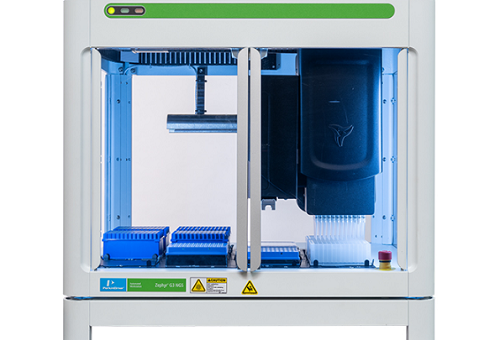
Zephyr® G3 NGS Workstation
It produces sequence-ready libraries with improved reproducibility and consistency
It minimize the labor-intensive steps associated with manual NGS sample preparation
The parallel processing of 96 samples in less than eight hours.
- Product description
- Consumables
- Citations
The Zephyr® G3 NGS workstation is a benchtop liquid handler designed to automate the construction of 48 to 96 next generation sequencing (NGS) libraries per day. The simplified user-interface and integrated hardware maximize laboratory productivity while reducing variability resulting from manual pipetting.
Over 40 automated methods for the Zephyr® G3 NGS liquid handler are available automating:
Post-PCR SPRI purification
qPCR setup (in 96-well or 384-well plates)
Plate transfer to the LabChip® GX Touch™ nucleic acid analyzer
Volume and/or concentration normalization
Indexed library pooling
NGS library construction
The Zephyr® G3 NGS workstation produces sequence-ready libraries with improved reproducibility and consistency while minimizing the labor-intensive steps associated with manual NGS sample preparation. With a walk-away solution and flexible sample processing (8 to 96 samples), the Zephyr® G3 NGS workstation is an ideal solution for medium throughput labs enabling the parallel processing of 96 samples in less than eight hours.
The Zephyr® G3 NGS workstation comes pre-configured with:
12 position deck
Simultaneous pipetting and gripper movement for improved efficiency
4-110°C thermal heater
Combined 4-70°C thermal heater and shaker
Disposable tip waste chute
Fully enclosure workstation
Guided application user interface
Verified, pre-developed application templates
Optional UV light
Specifications
Pipetting:
| Liquid Handling Options | Volume Range | Characteristic Performance | Tip Options |
HV Pipetting Head (96 Channels) | 1-200 μL | 1-5 μL: CV < 5% 5-200 μL: CV < 2% | 100 or 200 μL disposable tips |
| Dimensions | |
| Height | 660 mm | 26 in |
| Width | 762 mm | 30 in |
| Depth | 585 mm | 23 in |
Operating Temperature 15 – 35°C (59 to 95°F)
Operating Humidity 0 – 85% RH, non-condensing
Air Supply Regulated 65 psi
Power Input 115 VAC, 50/60 Hz, 1000 VA max.
or
230 VAC, 50/60 Hz, 1000 VA max.
Lids, Plates & Reservoirs:
Universal Lid
PCR Plate
Polypropylene Low-Volume Microplate
Polypropylene Storage Block
Polypropylene Deep-Well Storage Plate
Polypropylene Storage Plate
Polypropylene Deep-Well Reservoir
Pipette Tips:
80 μL
100 μL
150 μL
200 μL
Publications that Cite Using the Zephyr® G3 NGS Workstation
Bellott, D. W., Cho, T., Hughes, J. F., Skaletsky, H., & Page, D. C. (2018). Cost-effective high-throughput single-haplotype iterative mapping and sequencing for complex genomic structures. Nature Protocols, 13(4), 787-809. doi:10.1038/nprot.2018.019.
Brandstetter, B., Dalwigk, K., Platzer, A., Niederreiter, B., Kartnig, F., Fischer, A., . . . Karonitsch, T. (2019). FOXO3 is involved in the tumor necrosis factor-driven inflammatory response in fibroblast-like synoviocytes. Laboratory Investigation. doi:10.1038/s41374-018-0184-7
Griss, J., Bauer, W., Wagner, C., Maurer-Granofszky, M., Simon, M., Chen, M., . . . Wagner, S. N. (2018). B cells sustain inflammation and improve survival in human melanoma:. doi:10.1101/478735.
Gösch, L., et al. (2018) A T cell-specific deletion of HDAC1 protects against experimental autoimmune encephalomyelitis. Journal of Autoimmunity. (86). doi.org/10.1016/j.jaut.2017.09.008.
Klumpp, J., Staubli, T., Schmitter, S., Hupfeld, M., Fouts, D. E., & Loessner, M. J. (2014). Genome Sequences of Three Frequently Used Listeria monocytogenes and Listeria ivanovii Strains. Genome Announcements, 2(2). doi:10.1128/genomea.00404-14.
Li, Jin, et al. (2017) Artemisinins Target GABAA Receptor Signaling and Impair a Cell Identity. Cell. 168 (1) 86 – 100.e15.
Skucha, A., Ebner, J., Schmöllerl, J., Roth, M., Eder, T., César-Razquin, A., . . . Grebien, F. (2018). MLL-fusion-driven leukemia requires SETD2 to safeguard genomic integrity. Nature Communications,9(1). doi:10.1038/s41467-018-04329-y.
Trolle, C., et al. (2016) Widespread DNA hypomethylation and differential gene expression in Turner syndrome. Scientific Reports (6) doi:10.1038/srep34220 .








